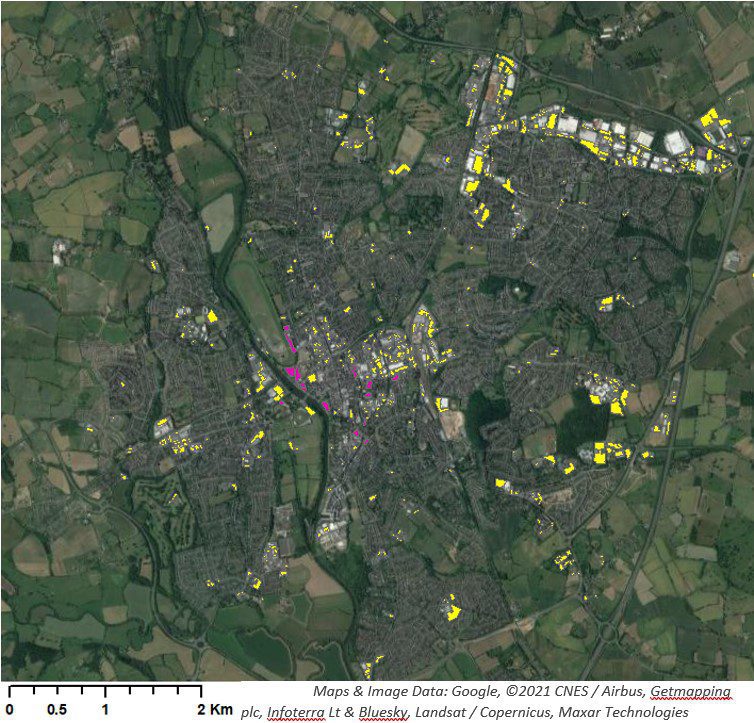Mapping PNR parking for reuse and redevelopment by WPI students (words) and University of Worcester student Ira Spiridonova (digital media)
This student-led project quantified and mapped private non-residential (PNR) parking in Worcester and Gloucester
Through the University of Worcester’s continuing partnership with Worcester Polytechnic Institute, students created a mapping tool tested in two cities to highlight the potential opportunities for reuse and redevelopment associated with surplus PNR parking.
Worcester City Council has set a goal of carbon neutrality by 2030; central to achieving this is a reduction in traffic, particularly petrol or diesel-engine cars, in and around the city centre. The recent pandemic has contributed to more people working from home and changed traffic peaks. Current forecasts predict a 30% decrease in the need for parking facilities in the long term due to companies adoption of working from home, and the potential for a surplus of parking spaces that could be reused and redeveloped.
PNR parking is unregulated in Worcester and many other UK cities which means city officials lack clarity around where parking is located and how much it is being used – or unused. A plentiful supply of PNR parking makes it easier for people to drive walkable distances and disincentives the use of public transport. This, together with a lack of clarity around the availability and use of parking facilities, presents several challenges to city planners attempting to discourage car use in and around city centres.
Recognising these challenges, the goal of this project was to develop a procedure to assess, quantify, and map PNR parking to highlight the potential for the reuse and redevelopment of excess parking. This research could then be used to inform city planning that effectively utilises excess parking facilities and promotes sustainable travel.

Findings identified 429 PNR carparks in Worcester, containing 55,000 parking spaces which occupy an area of almost one square kilometre within the city. If 10% of this space were to be converted into houses, nearly 1000 three-bedroom homes could be built within the city. In contrast to the number of PNR parking spaces, there are approximately 2,500 municipal parking spaces in the city of Worcester.
One of Worcester’s long-standing goals has been to decrease car traffic within the city centre. Reducing parking spaces within this area would discourage car traffic, since commuters would have difficulty parking. The analysis discovered the city centre, despite the city’s effort to reduce car traffic, contained 114 PNR carparks and the second-highest number of parking spaces. The location with the most PNR parking spaces was the area located between 2km and 3km from the city centre. There are approximately 18,000 parking spaces, totalling around 33% of the city’s total PNR parking provision.

To gain a deeper understanding of parking provision, we held interviews with several field experts about the following topics: congestion, consolidated parking, repurposing carparks, improving public transportation, and the implementation of a workplace parking levy. Congestion in the city centre is a significant problem in part due to the several small public carparks spread through the city. By consolidating these carparks into larger carparks on the outskirts of the city, the congestion would improve as commuters could park in the larger carparks and take public transportation. This would allow some of the small carparks to be repurposed into parklets, housing, or bike storage. All interviewees thought implementing a workplace parking levy would help address the issue of traffic congestion.
With the assumption of a 30% decrease in parking post-pandemic, roughly 16,500 of these parking spaces would be underused. Therefore, we recommend:
- The repurposing of unused parking areas as parklets, bike storage, housing, or other useful spaces. This would help reduce congestion in the city centre.
- The implementation of a workplace parking levy to create a cash flow for improving public transportation or repurposing the underused lots.
- The hiring of students to update or create new maps as this is a long but simple process. Students can be instructed to use our detailed procedure to ensure uniformity in mapping and to decrease the mapping time and ArcGIS learning curve.
For more information about this project, please contact Katy Boom at k.boom@worc.ac.uk.
Mapping PNR parking for reuse.